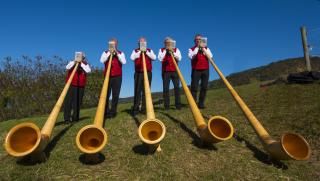Swiss Fun Facts #2:
From crooked fir tree to Swiss national instrument
About 3.5 meters long, weighing up to eight kilograms, conical, and bent like a cow horn at the end – it is the musical instrument of Switzerland: the Alphorn.
People have been playing the woodwind instrument for more than 500 years. For a long time shepherds used it to call their cows in from the pasture to their stable. During milking, it was blown gently in order to soothe the dairy cattle. And in the evening, the Alphorn blower played his tune to bring the communities together for evening prayer.
And who invented it, the Swiss? The Alphorn was in fact mentioned for the first time in the mid 16th century in Switzerland, although when and where exactly it was developed is still unknown.
By the end of the 18th century the Alphorn was heard only rarely in the Swiss mountains, which was probably due to the fact that its enormous length made travelling rather difficult. In order to prevent the extinction of the Alphorn, the Mayor of Bern Niklaus von Mülinen had Alphorns made and gave them away to talented players. In that way, the Alphorn gained importance as a musical instrument and increasingly became a symbol of Switzerland.
And who invented it, the Swiss? The Alphorn was in fact mentioned for the first time in the mid 16th century in Switzerland, although when and where exactly it was developed is still unknown.
By the end of the 18th century the Alphorn was heard only rarely in the Swiss mountains, which was probably due to the fact that its enormous length made travelling rather difficult. In order to prevent the extinction of the Alphorn, the Mayor of Bern Niklaus von Mülinen had Alphorns made and gave them away to talented players. In that way, the Alphorn gained importance as a musical instrument and increasingly became a symbol of Switzerland.
Traditionally, young fir trees standing on slopes – causing them to grow crooked – were cut lengthwise, hollowed out, put back together again and wrapped with roots or linen strips for better stability. This construction method called for more than 70 hours of pure manual work. Modern Alphorns consist of at least three components, which are individually hollowed out, ground and put back together using metal rings. The more even the walls of the Alphorn, the clearer is its sound. Similarly to the way in which the AIR-FLOW®-method has established itself as the more precise and efficient procedure compared to hand instruments, the manual production of Alphorns was increasingly replaced by high-precision mechanical milling. Despite experience and routine, manual work cannot match the excellent results achieved by machining. After the woodworking and painting, a rattan coat is placed around the tube at the end.
The tonal range of the Alphorn varies with its length, as it has no valves or flaps. In Switzerland it has an average length of 3.5 metres and enables 16 natural tones that seamlessly merge into one another. A special and easily learnable blowing technique with lungs and lips makes the air in the pipe resonate and ultimately produces a sound that can be heard at distances of up to 10 km.
The Swiss Yodelling Association currently has 1800 registered Alphorn players around the world, who come together regularly at international meetings and keep the tradition of the Alphorn alive.

